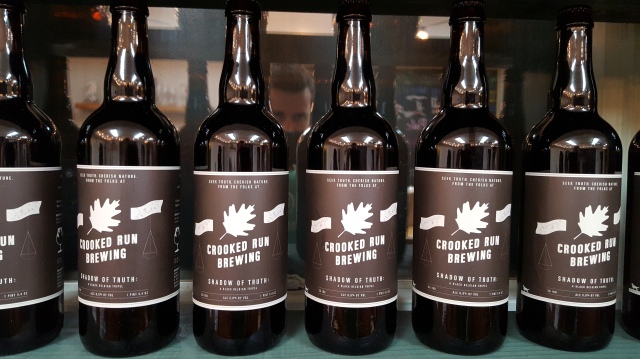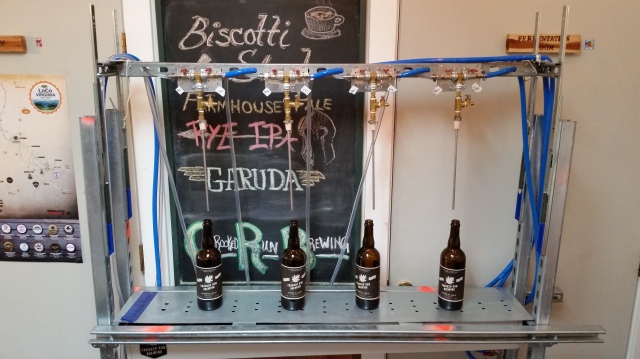We have bottles! Lee and I have been talking about this for over a year, and I am very happy to say that we will now be doing small runs of some of our bigger beers in 750 ml bottles for sale at the brewery and local bottle shops. What does it take to bottle? A lot goes into it.

First, the bottles themselves. We chose thick, Belgian-style 750 ml bottles with crown caps. I really like the bomber format, and I feel it is very conducive to flavorful, high-ABV beers, where you are likely to share the beer with others. We will only be bottling these styles of our beers, since I want our beers to be able to stand up to a bit of aging in case they linger on shelves.
Second, the labels. Our very talented graphic design and branding guy worked on our first label along with our logo refresh. The label is simple, easy to read, and recognizable. You can go many different directions with a label, but this was always what we wanted. For the material, we wanted either felt or biaxially oriented polypropylene (BOPP). We chose BOPP because it is pretty much waterproof, and a lot easier to apply, unlike felt. I am very glad that we did–our first run would have been fairly unpleasant with felt labels.

Now, on to the fun part–the machine! Lee built this four-head counterpressure filler. After looking at various youtube videos, we came up with this unique design. It is built of Unistrut, and uses drawer slides to move the manifold and fillers up and down so that bottles can be placed underneath. There is a trough underneath that runs to a drip bucket. Not counting the Unistrut which was free, the total cost for this part of the project was $400 for parts. Not too bad, considering most similar fillers you can buy run at least $2000.

Our friend Frank built us this label machine. It’s hand operated, and works like a charm. The only change we are going to make is to add a small piece that applies some pressure to the surface of the label/bottle to keep it smooth. Total cost: some beer for Frank.
Before we bottled, we wanted to get our beer tested to make sure it will be shelf-stable. This part is very important. All of our beer comes out clean-tasting, but since we brew and serve beer in a tiny space, I have always had my doubts as to just how clean our beer actually is. (This is why we never repitch yeast.) If it’s going to sit around warm for weeks or months, it can’t be at risk for refermenting or souring. Jasper Akerboom at Bright Yeast Labs took a look at our beer for us. As it turns out, it was free of microbes or brett, but has a little bit of wild yeast. Since the beer we are bottling is extremely dry, I am not particularly worried about this, as there is practically nothing left to ferment. We will keep trying to get our beer to be as clean as possible.
We set up everything on Sunday morning for a small little run: five cases of Shadow of Truth, our black Belgian tripel. We had two hours budgeted for the run in a very long day that included a double batch, opening the tasting room, and removing our entire grain milling area (more on this later). Our friends Nicole and Corey came by to assist. We were done in one hour! Everything went about as smoothly as it could. The machine works perfectly–there is practically zero foam. We can even reduce times in the future with a bit more CO2 pressure to speed up fills.
As I mentioned before, our beer wasn’t 100% clean, but this will hopefully be negligible on a beer like Shadow that has an FG of 1.002/0.5. One of the ways I believe will improve sanitation was to store and mill our grain off-site, since we lack a partitioned area to mill in, and milling creates a tremendous amount of dust. We built a small shed in my basement with a dehumidifier, and now all the cluttered piles of grain bags are stored there. This has three great benefits: reduced dust, looks way neater to customers, and allows us to finally start our barrel program! More info to come on this.
Next on the bottling list: Valhalla golden stout, Supernatural hibiscus saison, and Machismo smoked chipotle RIS.

This is fantastic news! Congrats on this step.
Thanks Paul!
Cool. How did you manage to get rid of the milling area, or did you just move it?
We just moved it off-site. Lee and I built a shed in my basement, with a chemical dehumidifier inside, plus a dehumidifier running in the basement.
Very nice set up! Just got into homebrewing and trying to make bottling much easier and not a dreadful task. Love the bottle filler. How does the sliding part stay in the upright position to swap out the bottles? Would love to make a similar one on a smaller scale.
Thanks! It has a bolt which can be locked. Usually I just hold it up while whoever is capping grabs the bottles.